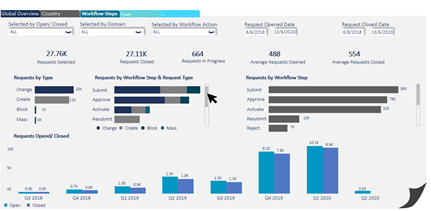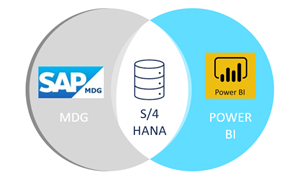
SAP PP-Predictive MRP, Something to Know!
In this article, we focus on the new proposition of SAP PP-Predictive MRP and explain the interest it.

Data is vital as it is the basis for organizations to set strategic goals, define plans and decide on the best actions. To support this, data visualization is crucial. It allows the organizations’ executives to gain insights and take the right decisions. Integrating Microsoft Power BI to SAP Master Data Governance (MDG) as a data source will help your data management leads to understand their data by consuming the hub of business’ internal master data and its processes, visualizing all its data on Power BI. The result is a customizable application full of tools, widgets, and illustrations that make the data come alive.
SAP MDG offers process analytics, but it is restricted in multiple areas and only customizable to a certain extent with limited options when it comes to drilling down options and personalized reports. Knowing that, some insights can be missed out when not being able to display and evaluate specific scenarios or patterns which may lead to false or inaccurate judgements. Such challenges can be tackled by providing the data to a platform that can accurately plot and highlight insights and is flexibly adjustable to your needs.
Microsoft Power BI is a platform which contains a collection of software services and applications. These applications offer interactive visualizations and business intelligence capabilities that can transform your disparate sources of data into logical, visually immersive, and interactive insights. All of that comes in handy for users to develop their own reports and dashboards with an interface which is easy and flexible enough for customization. In addition, it can be easily combined with different other solutions from Microsoft Office Suite, for example to publish reports from Microsoft Teams or Microsoft SharePoint.
Power BI can be integrated to various data sources and by having SAP MDG as an option, it supports understanding the current data quality and visualizes any process performance issues. By integrating Power BI with SAP MDG, responsible people like Data Stewards can be more proactive about the decisions by taking an active part in identifying all the issues with the visualized data and assure the data quality in all specified areas.
One exemplary use case of this integration is displaying the MDG change requests with different variations such as timing periods, workflow steps or actions which is shown in the visualization below. Furthermore, the combination of process and master data information can be easily analyzed by using the flexibility of Microsoft Power BI. This information will enable the people responsible to track their internal process along with assuring the data quality.

Integrating Power BI to SAP MDG can be realized by numerous approaches. The most common methodology is by connecting Power BI to the MDG database tables of the underlying S/4HANA system. A direct connection between them can be established easily and without any third-party or external layers. This makes the data accessible for representations/visualizations on Power BI. This approach has the main benefit of being able to access data directly from the database layer with high performance, especially in case an SAP HANA Database is used.

As direct database connections might not be allowed in some organizations, integration can also be achieved via OData Services. By using the OData Feed option, Power BI connects to the available tables and other data elements linked to it. Using this approach, data used for your analysis can easily be consumed and refreshed at any point of time. Furthermore, from a security perspective the connection can be controlled easily by using SAP standards authorization mechanisms.
Data analytics is a crucial area because it helps businesses optimizing their performance. By using data analytics, companies can monitor their data quality and process performance to make better business decisions. And by integrating SAP MDG with Power BI, companies will be combining one of their major data sources with one of the best tools in data visualizations.
We would like to thank Ziad Abdelkader and Patrick Szymaniec for their valuable contribution to this article.

In this article, we focus on the new proposition of SAP PP-Predictive MRP and explain the interest it.

This article shall help you to understand how to optimize your inventory positions in a month – or even less.

Modern PLM systems empower businesses to achieve product excellence in fast-paced markets by enhancing collaboration, agility and innovation.

Read how the Campaign Planner & Designer (CPD) helps you to manage supply chain variability.
© Camelot Management Consultants, Part of Accenture
Camelot Management Consultants is the brand name through which the member firms Camelot Management Consultants GmbH, Camelot ITLab GmbH and their local subsidiaries operate and deliver their services.